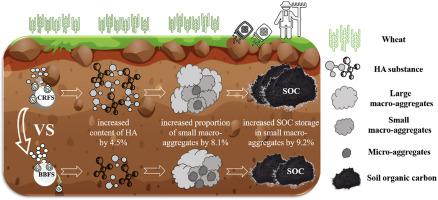Journal of Cleaner Production ( IF 9.7 ) Pub Date : 2023-06-21 , DOI: 10.1016/j.jclepro.2023.137783 Yongxiang Gao , Haojie Feng , Min Zhang , Yuqing Shao , Jiaqi Wang , Yanli Liu , Chengliang Li

|
Soil organic carbon (SOC) sequestration effectively reduces global CO2 emissions while ensuring crop production and sustainable agricultural development. Evaluating the effects of straw returning combined with controlled-release nitrogen (N) fertilizer on soil organic carbon (SOC) sequestration is necessary. We conducted a long-term (2013–2018) insitu field trial with six treatments: straw combined with no N and two N fertilizer types [no N fertilizer (CKS), conventional N fertilizer (BBFS) and controlled-release N fertilizer (CRFS)] and their corresponding no N and two N fertilizer treatments (CK, BBF, and CRF), each in three replicates. Overall, straw returning combined with N fertilizer (BBFS and CRFS) improves carbon storage and crop yield by changing aggregate distribution, with the effect of CRFS being more substantial. We further found CRFS treatment significantly increased SOC storage in small macro-aggregates (0.25–2 mm) by 9.2% and 28.4%, respectively, compared to BBFS and CKS treatments, which is mainly due to CRFS treatment increasing the proportion of small macro-aggregates (0.25–2 mm) by 8.1% and 20.1%, respectively, in contrast with BBFS and CKS treatments. Compared to BBFS and CKS treatments, CRFS treatment increased the fluorescence intensity of hydrophobic compounds in humic acid (HA) by 45.0% and 107.6%, respectively. Similarly, in small macro-aggregates (0.2–2.5 mm), CRFS treatment significantly increased the fluorescence intensity of hydrophobic compounds in HA. Lastly, structural equation modeling showed that straw returning treatments promote aggregate formation and carbon sequestration by increasing the fluorescence intensity of hydrophobic compounds in HA, ultimately increasing crop yield. Therefore, CRFS treatment is theoretically an effective method to promote SOC storage and increase crop yield and is a viable practice for sustainable agriculture.
中文翻译:

秸秆还田结合控释氮肥通过改变腐植酸组成和团聚体分布影响有机碳储量和作物产量
土壤有机碳(SOC)封存有效减少全球CO 2排放,同时保证作物生产和农业可持续发展。有必要评估秸秆还田结合控释氮肥对土壤有机碳固存的影响。我们进行了长期(2013-2018)原位田间试验,有六种处理:秸秆结合无氮和两种氮肥类型[无氮肥(CKS)、常规氮肥(BBFS)和控释氮肥(CRFS) )] 及其相应的无氮肥和两次氮肥处理(CK、BBF 和 CRF),每个处理重复 3 个。总体而言,秸秆还田结合氮肥(BBFS和CRFS)通过改变总量分布来提高碳储量和作物产量,其中CRFS的效果更为显着。我们进一步发现 CRFS 处理显着增加了 SOC 存储与 BBFS 和 CKS 处理相比,小宏观团聚体(0.25-2 mm)的比例分别增加了 9.2% 和 28.4%,这主要是由于 CRFS 处理将小宏观团聚体(0.25-2 mm)的比例增加了 8.1与 BBFS 和 CKS 处理相比,分别为 % 和 20.1%。与BBFS和CKS处理相比,CRFS处理增加了腐殖酸中疏水性化合物的荧光强度(HA) 分别增加 45.0% 和 107.6%。同样,在小的宏观聚集体(0.2-2.5 mm)中,CRFS 处理显着增加了 HA 中疏水性化合物的荧光强度。最后,结构方程模型表明,秸秆还田处理通过增加HA中疏水性化合物的荧光强度来促进团聚体形成和碳固存,最终提高作物产量。因此,CRFS处理理论上是促进SOC储存、提高作物产量的有效方法,是可持续农业的可行实践。















































 京公网安备 11010802027423号
京公网安备 11010802027423号